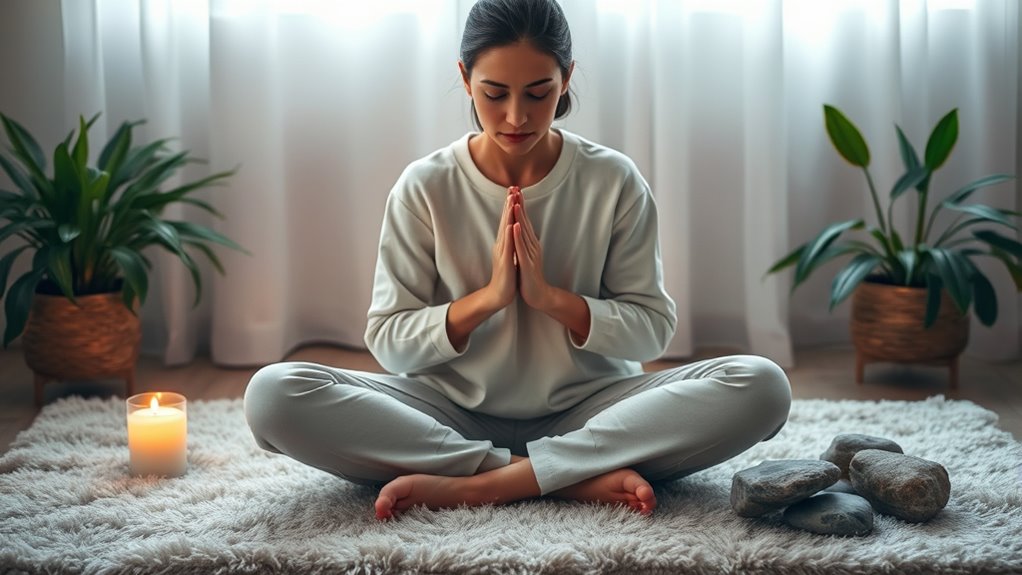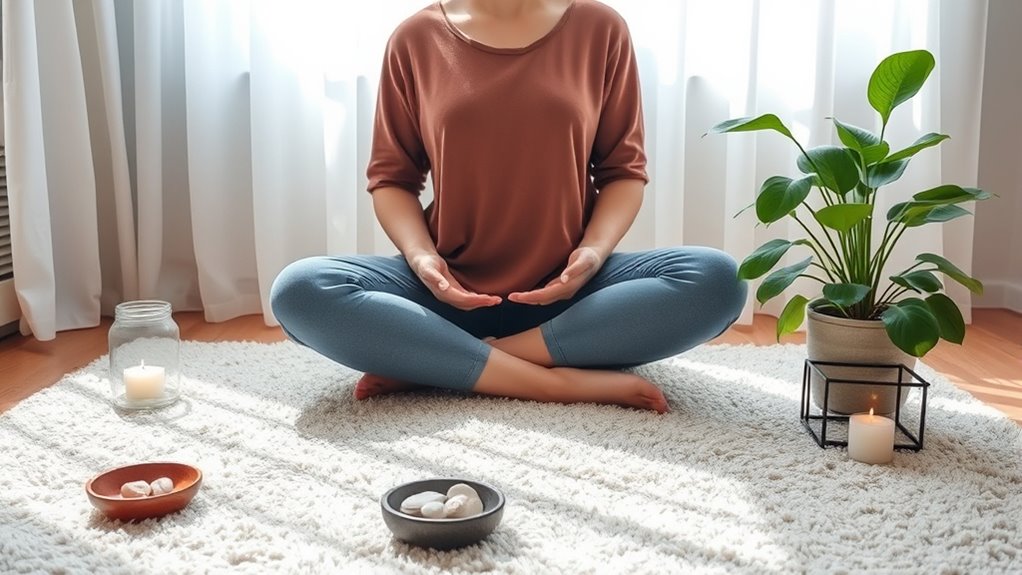When a panic attack hits, grounding techniques can help you regain control by anchoring you in the present. Try the 5-4-3-2-1 method: identify five sights, four sounds, three touches, two smells, and one taste around you. Practice deep breathing, visualize calming scenes, or move your body gently to ease tension. Creating a safe space and developing a personalized routine can also make a big difference. Keep exploring these strategies to find what works best for you.
Key Takeaways
- Use the 5-4-3-2-1 grounding technique to engage your senses and stay present during a panic attack.
- Practice deep breathing combined with visualization of calming scenes to reduce physical symptoms.
- Incorporate movement exercises like stretching or walking to restore body awareness and ease anxiety.
- Create a safe, calming environment with soothing objects and mindful journaling for self-soothing.
- Identify personal triggers through reflection and tailor grounding strategies to maintain control during episodes.
Recognizing the Signs of a Panic Attack

Recognizing the signs of a panic attack is essential for managing it effectively. When you become aware of panic symptoms, you can respond calmly instead of panic spiraling out of control. Common panic symptoms include rapid heartbeat, sweating, trembling, chest tightness, and shortness of breath. You might also notice feelings of dizziness, nausea, or chills. Developing emotional awareness helps you identify these early warning signs before the attack intensifies. Pay attention to your body’s signals and thoughts, noting when feelings of fear or dread appear unexpectedly. This awareness allows you to intervene sooner, reducing the attack’s impact. Additionally, understanding physiological responses associated with panic attacks can improve your ability to distinguish between anxiety and other medical conditions. Recognizing physical cues that indicate rising anxiety can help you act proactively. By understanding these physical and emotional cues, you gain better control over your reactions and set the stage for grounding techniques to work effectively. Incorporating mindfulness strategies can further enhance your ability to recognize and respond to these signs with calmness and clarity. Being familiar with common triggers can also help you anticipate and prepare for potential episodes, making your management strategies more effective.
Deep Breathing Exercises to Calm Your Mind

When you feel a panic attack starting, deep breathing exercises can help calm your mind and body quickly. Focus on mindful breathing by taking slow, deliberate inhales through your nose, allowing your lungs to fill completely. Exhale slowly through your mouth, releasing tension with each breath. To enhance the effect, picture calming visuals like a peaceful lake or gentle waves, helping you stay grounded. Concentrate on the sensation of your breath and the calming imagery to distract your mind from racing thoughts. This simple practice reduces anxiety and restores a sense of control. Regularly practicing mindful breathing and visualizing calming scenes can make these techniques more effective during moments of distress. Remember, slow, intentional breaths are your ally in calming panic attacks. Additionally, understanding the importance of grounding techniques can help reinforce your ability to stay centered during stressful moments, especially when incorporating visualization methods and other sensory-focused strategies. Techniques like controlled breathing also support the relaxation response, helping to counteract the physical symptoms of panic attacks and promote emotional stability.
The 5-4-3-2-1 Grounding Technique

The 5-4-3-2-1 grounding technique helps you stay present by using your senses. First, you’ll recognize specific sensory triggers that signal a panic attack is starting. Then, you’ll follow a simple step-by-step method to anchor yourself in the moment. Incorporating mindfulness practices can further enhance your ability to manage anxiety effectively. Engaging in preppy dog names can also serve as a comforting distraction, helping redirect your focus during heightened moments. Remembering the importance of Mom – Amazing Life Together can remind you of ongoing support and love, even during challenging times. Practicing sleep hygiene can improve overall emotional regulation, making it easier to stay grounded when anxiety arises. Utilizing visualization techniques can deepen your focus and help calm your mind during stressful episodes.
Recognizing Sensory Triggers
Understanding your sensory triggers is a crucial step in managing panic attacks, as it helps you stay grounded during intense moments. Sensory overload often occurs when your senses become overwhelmed by sights, sounds, or smells, making it harder to stay calm. By developing emotional awareness, you learn to recognize early signs of sensory overload before panic takes hold. Pay attention to subtle cues, like increased heart rate or feeling overwhelmed, to identify triggers. Once you’re aware of what affects you, you can prepare to use grounding techniques, such as the 5-4-3-2-1 method, to refocus your mind. Recognizing your sensory triggers can be supported by using tools like portable camping gear, which empowers you to intervene early, reducing the severity of panic attacks and fostering greater emotional control during stressful situations. Incorporating mindfulness practices such as meditation or deep breathing exercises can further enhance your ability to manage sensory overload. Additionally, being aware of vehicle tuning options can help you maintain a sense of control and comfort in your environment, further reducing stress responses. Developing a personalized coping plan that includes these strategies can strengthen your resilience and confidence in handling sensory triggers effectively.
Step-by-Step Method
The 5-4-3-2-1 grounded technique offers a simple and effective way to bring your focus back to the present during a panic attack. By engaging your senses, you can practice mindfulness meditation and cognitive reframing to reduce anxiety. Start by identifying five things you see, four you hear, three you touch, two you smell, and one you taste. This structured approach helps redirect your thoughts away from fear. Remember, incorporating emotional readiness and proper communication can enhance the effectiveness of grounding techniques during stressful moments. Recognizing the dog breeds associated with calm and friendly traits can also provide additional comfort during anxiety. Utilizing privacy policies can help you understand how your data is managed if you access online resources for relaxation techniques.
Using Your Senses to Anchor Yourself

During a panic attack, focusing on your senses can help ground you in the present moment. Sensory awareness is a powerful tool that taps into your five senses, anchoring your mind away from distressing thoughts. Use mindfulness practices like noticing the texture of an object, the sounds around you, or the temperature of the air on your skin. For example, touch a nearby object and concentrate on its feel, or listen carefully to the ambient noises. Pay attention to what you see, hear, smell, and feel without judgment. Engaging your senses redirects your focus, reducing anxiety and helping you regain control. This simple yet effective grounding technique keeps you connected to the here and now, easing the intensity of your panic attack.
Engaging Your Body Through Movement

Shifting your focus from your senses to your body can help break the cycle of panic. Engaging in movement therapy or proprioception exercises encourages your body to reconnect, reducing anxiety. Simple actions like stretching, walking, or gentle bouncing can ground you quickly. These activities activate your body’s awareness, helping you regain control.
| Movement Ideas | Benefits |
|---|---|
| Walking or jogging | Distracts and calms your mind |
| Stretching | Releases tension |
| Bouncing on your heels | Improves proprioception |
| Arm circles | Reenergizes and centers |
Visualization Methods for Immediate Relief

Visualization techniques can provide quick relief by helping you redirect your focus away from panic sensations. By engaging in mental rehearsal or guided imagery, you can create a calming mental environment. Here are three effective methods:
- Picture a peaceful place: Visualize yourself in a calming setting, like a beach or forest, focusing on sights, sounds, and smells.
- Use guided imagery: Follow a recorded visualization that guides you through a relaxing scene, anchoring your attention away from panic.
- Practice mental rehearsal: Visualize yourself successfully steering through a stressful situation, reinforcing confidence and reducing anxiety.
These techniques help ground you in the present moment and diminish the intensity of panic symptoms. Incorporate visualization into your toolkit for immediate relief whenever panic strikes.
Creating a Safe Space for Self-Soothing

Creating a safe space for self-soothing involves intentionally designing an environment or mental setting where you feel secure and calm. You can start by creating a calming environment—dim lighting, soft textures, or comforting objects—that help you feel grounded. Incorporate mindful journaling into this space by writing down your thoughts or feelings in a gentle, non-judgmental way. This practice helps you process emotions and regain control during a panic attack. Focus on making the space personalized and free of distractions. When you establish this environment, you create a mental refuge you can return to anytime you need to self-soothe. Over time, this safe space becomes a powerful tool for managing anxiety and fostering inner calm.
Developing a Personal Grounding Routine

To create an effective grounding routine, you need to recognize what triggers your panic attacks and choose methods that work best for you. By understanding your personal triggers, you can develop strategies that help you feel more in control. Selecting grounding techniques tailored to your needs guarantees you’re prepared when anxiety strikes.
Identifying Personal Triggers
Understanding your personal triggers is a crucial step in developing an effective grounding routine for panic attacks. Recognizing what sparks your anxiety helps you prepare and respond more effectively. To identify these triggers, consider these key steps:
- Track your emotions daily to build emotional awareness and notice patterns that lead to panic.
- Reflect on recent stressors or situations that heightened your anxiety.
- Keep a journal to document specific events, environments, or thoughts that precede your attacks.
Selecting Grounding Methods
Once you’ve identified your personal triggers, the next step is to choose grounding methods that work best for you. This involves exploring different mindfulness practices and grounding tools to find what calms your mind and body during a panic attack. Some people find deep breathing exercises effective, while others prefer sensory grounding tools like holding a textured object or smelling a familiar scent. Incorporate activities such as focusing on your surroundings, counting objects, or listening to calming sounds. Building a personal grounding routine means experimenting with these techniques until you discover what helps you feel more centered and in control. Consistently practicing your chosen methods guarantees they become reliable tools to manage panic moments effectively.
Frequently Asked Questions
Can Grounding Techniques Prevent Future Panic Attacks?
You might wonder if grounding techniques prevent future panic attacks. While they can’t guarantee prevention, practicing mindfulness exercises and breathing techniques regularly helps you stay present and reduce anxiety. These tools strengthen your ability to manage stressful moments, making you less likely to experience severe panic. Consistent use builds resilience, so you’re better prepared to handle triggers and potentially lessen the frequency or intensity of future panic attacks.
Are Grounding Methods Effective for Severe Panic Episodes?
You might think grounding methods aren’t enough during severe panic episodes, but they can be surprisingly effective in crisis. These techniques serve as a strong coping mechanism, helping you regain control and reduce overwhelming feelings quickly. While they may not eliminate panic entirely, they provide immediate relief and stability, making them a valuable tool when you’re in the thick of a severe panic attack.
How Long Should I Practice Grounding Techniques Each Day?
You might wonder about the duration guidance for practicing grounding techniques daily. To build a helpful daily routine, aim for 5 to 15 minutes each day, gradually increasing as you feel comfortable. Consistency is key, so incorporate these practices into your routine whenever you need them. There’s no strict time limit, but regular practice helps you manage anxiety better and makes grounding techniques more effective during panic episodes.
Can Grounding Help With Anxiety Unrelated to Panic Attacks?
You might find that grounding techniques can definitely help with anxiety that’s not related to panic attacks. Incorporate mindfulness practices and relaxation exercises into your routine to stay present and calm. These methods help manage ongoing worry and stress by shifting your focus away from anxious thoughts. Consistent practice boosts your resilience over time, making it easier to handle daily anxiety and stay centered in challenging moments.
Are There Any Contraindications for Using Grounding Techniques?
You might wonder if there are any medical contraindications or sensory sensitivities that could affect your use of grounding techniques. While generally safe, if you have severe sensory sensitivities or certain medical conditions, grounding exercises could trigger discomfort or overstimulation. It’s best to consult with a healthcare professional to confirm these techniques suit your specific needs and won’t cause adverse effects. Adjusting methods can help you benefit safely.
Conclusion
Remember, you hold the power to anchor yourself amidst chaos. Picture yourself standing firm on solid ground, feeling the warmth of sunlight or the cool breeze against your skin. These grounding techniques are your toolkit—like a lighthouse guiding you through stormy seas. With practice, you’ll find your safe harbor within, ready to face panic attacks with calm and confidence. Trust in your ability to reclaim peace, one moment, one breath at a time.









